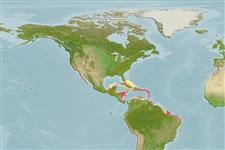>
Ophidiiformes (Cusk eels) >
Dinematichthyidae (Viviparous brotula)
Etymology: Ogilbia: Taken from Ogilby, 1887-1915, icthiologist and zoologist (Ref. 45335); jeffwilliamsi: Named for Dr. Jeffrey T. Williams, USNM.
Eponymy: James Douglas Ogilby (1853–1925) was an Irish-born Australian ichthyologist and taxonomist, son of the famous zoologist William Ogilby (below). [...] Dr Jeffrey T Williams. (See Williams) (Ref. 128868), visit book page.
More on authors: Møller, Schwarzhans & Nielsen.
Environment: milieu / climate zone / depth range / distribution range
Ecologia
marinhas associadas(os) a recifes; intervalo de profundidade 0 - 15 m (Ref. 57883). Tropical
Western Atlantic: Caribbean Sea, Belize, Panama, through Venezuela to Trinidad and Tobago and northward along the Antilles to Navassa.
Tamanho / Peso / Idade
Maturity: Lm ? range ? - ? cm
Max length : 5.6 cm SL macho/indeterminado; (Ref. 57883); 6.1 cm SL (female)
Descrição suscinta
Chaves de identificação | Morfologia | Morfometria
Raios dorsais (total) : 71 - 82; Raios anais : 52 - 61; Vértebras: 40 - 44. This species is characterized by the following: Vertebrae 11-13 + 29-32 = 40-44, dorsal fin rays 71-82, anal fin rays 52-61; outer pseudoclasper wingshaped with single curved supporter anteriorly; inner pseudoclasper club-shaped, with prominent appendix inserted at posterior-distal angle; small fleshy lobe at base of hood adjacent to outer pseudoclasper, penis
tapering; opercular spine with single, sharp tip; scale patch on cheeks with 6-9 vertical scale rows; otolith length: height ratio 2.2-2.3; green pigment globules in head and body mucus (Ref. 57883).
Inhabits rocky and coral reefs, in depths down to about 15 m. A few specimens are known from mangrove habitats. A 58 mm SL female specimen contains about 50 eggs, diameter 0.3-0.5 mm and 55 embryos, 6-8 mm TL, with 2 long rows of pigment spots along mid-body and dorsal fin base (Ref. 57883).
Ciclo de vida ou comportamento de acasalamento
Maturidade | Reprodução | Desova | Ovos | Fecundidade | Larvas
Møller, P.R., W. Schwarzhans and J.G. Nielsen, 2005. Review of the American Dinematichthyini (Teleostei: Bythitidae). Part II. Ogilbia. aqua, J. Ichthyol. Aquat. Biol. 10(4):133-207. (Ref. 57883)
Status na Lista Vermelha da UICN (Ref. 130435: Version 2024-2)
Ameaça para os humanos
Harmless
Uso pelos humanos
Ferramentas
Relatórios especiais
Baixar XML
Fontes da internet
Estimates based on models
Preferred temperature (Ref.
123201): 27 - 28.3, mean 27.6 °C (based on 274 cells).
Índice de diversidade filogenética (Ref.
82804): PD
50 = 0.5000 [Uniqueness, from 0.5 = low to 2.0 = high].
Bayesian length-weight: a=0.00389 (0.00180 - 0.00842), b=3.12 (2.94 - 3.30), in cm total length, based on all LWR estimates for this body shape (Ref.
93245).
Nível Trófico (Ref.
69278): 3.3 ±0.5 se; based on size and trophs of closest relatives
Fishing Vulnerability (Ref.
59153): Low vulnerability (10 of 100).
Nutrients (Ref.
124155): Calcium = 217 [115, 433] mg/100g; Iron = 1.08 [0.59, 1.92] mg/100g; Protein = 16.7 [14.1, 19.2] %; Omega3 = 0.116 [0.061, 0.217] g/100g; Selenium = 23.3 [10.8, 58.4] μg/100g; VitaminA = 139 [40, 486] μg/100g; Zinc = 2.84 [1.85, 4.13] mg/100g (wet weight);
